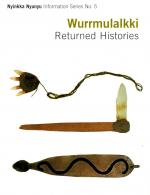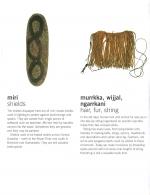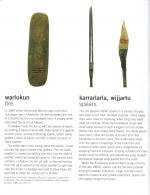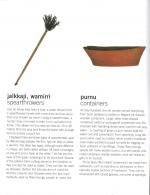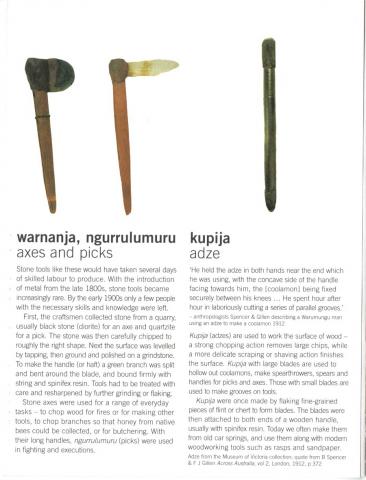Wurrmulalkki: Returned Histories (page 5)
warnanja, ngurrulumuru (axes and picks)
Stone tools like these would have taken several days of skilled labour to produce. With the introduction of metal from the late 1800s, stone tools became increasingly rare. By the early 1900s only a few people with the necessary skills and knowledge were left. First, the craftsmen collcted stone from the quarry, usually black stone (diorite) for an axe and quartsize for a pick. The stone was then carefully chipped to roughly the right shape. Next the surface was levelled by tapping, then ground and polished on a grindstone. To make the handle (or haft) a green branch was split and bent around the blade, and bound firmly with string and spinifex resin. Tools had to be treated with care and resharpened by further grinding or flaking. Stone axes were used for a range or everyday tasks - to chop wood for fires or for making other tools, to chop branches so that honey from native bees could be collected, or for butchering. With their long handles, ngurrulumuru (picks) were used in fighting and executions.
kupija (adze)
'He held the adze in both hands near the end which he was using, with the concave side of the handle facing towards him, the [coolamon] being fixed securely between his knees...He spent hour after hour in laboriously cutting a series of parallel grooves.' Kupija (adzes) are used to work the surface of wood - a strong chopping action removes large chips, while a more delicate scraping or shaving action finishes the surface. Kupija with large blades are used to hollow out coolamons, make spearthrowers, spears and handles for picks and axes. Those with small blades are used to make grooves on tools. Kupija were once made by flaking fine-grained pieces of flint or chert to form blades. The blades were then attached to both ends of a wooden handle, usually with spinifex resin. Today we often make them from old car springs, and use them along with modern woodworking tools such as rasps and sandpaper.
- anthropologists Spencer & Gillen describing a Warumungu man using an adze to make a coolamon 1912 ; Adze from the Museum of Victoria collection; quote from B Spencer & F J Gillen Across Australia, vol 2, London, 1912, p 372
